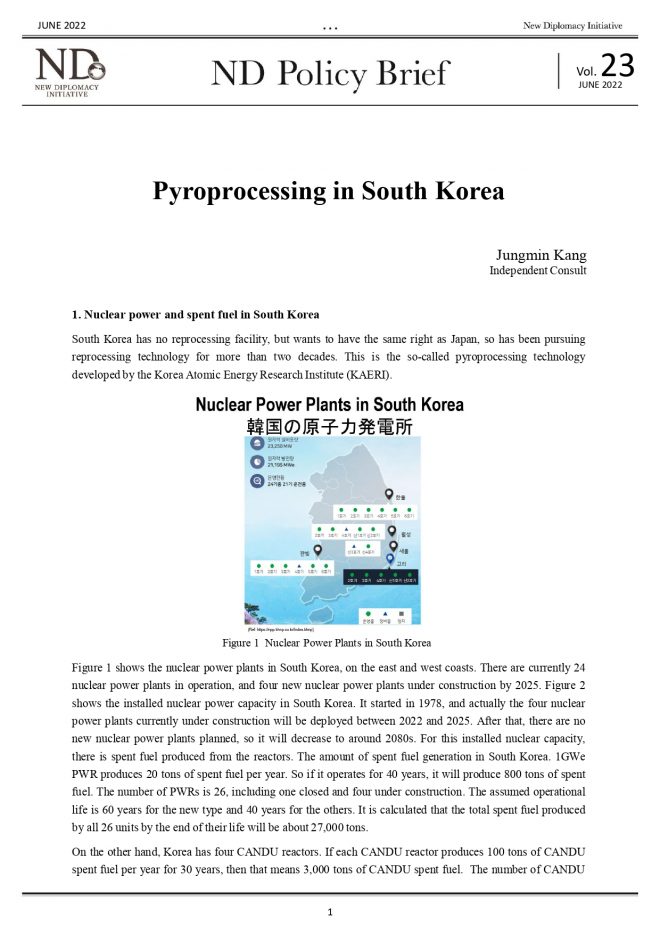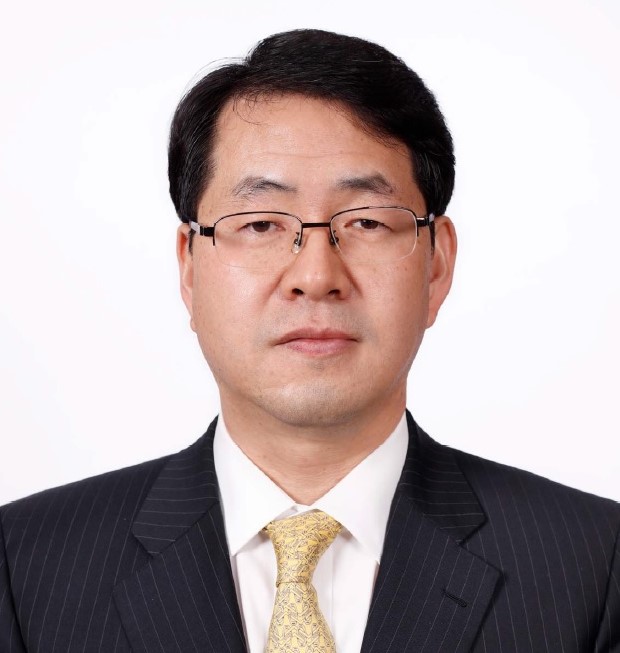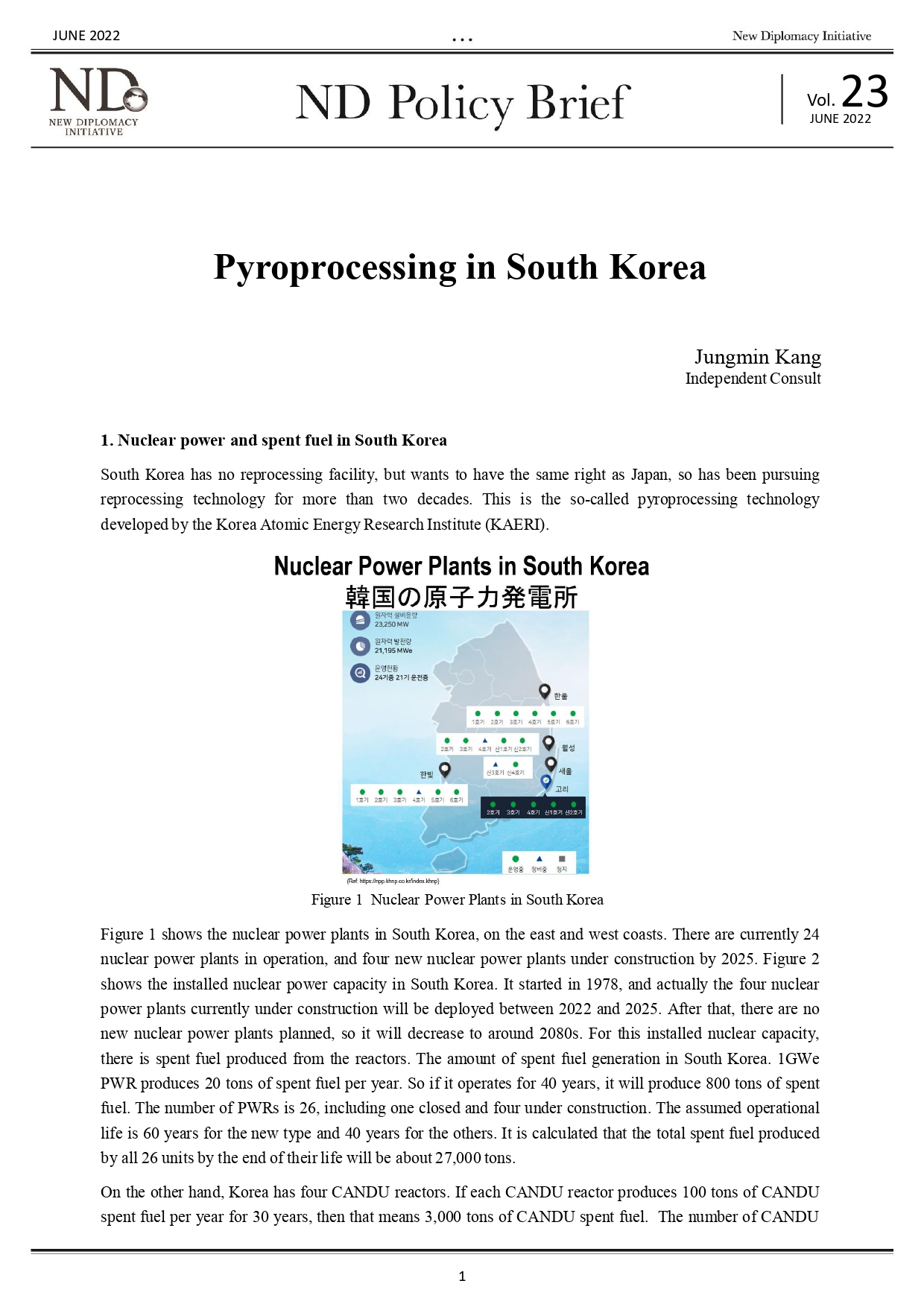Jungmin Kang
Independent Consult
1. Nuclear power and spent fuel in South Korea
South Korea has no reprocessing facility, but wants to have the same right as Japan, so has been pursuing reprocessing technology for more than two decades. This is the so-called pyroprocessing technology developed by the Korea Atomic Energy Research Institute (KAERI).
Figure 1 (see PDF) shows the nuclear power plants in South Korea, on the east and west coasts. There are currently 24 nuclear power plants in operation, and four new nuclear power plants under construction by 2025. Figure 2 shows the installed nuclear power capacity in South Korea. It started in 1978, and actually the four nuclear power plants currently under construction will be deployed between 2022 and 2025. After that, there are no new nuclear power plants planned, so it will decrease to around 2080s. For this installed nuclear capacity, there is spent fuel produced from the reactors. The amount of spent fuel generation in South Korea. 1GWe PWR produces 20 tons of spent fuel per year. So if it operates for 40 years, it will produce 800 tons of spent fuel. The number of PWRs is 26, including one closed and four under construction. The assumed operational life is 60 years for the new type and 40 years for the others. It is calculated that the total spent fuel produced by all 26 units by the end of their life will be about 27,000 tons.
On the other hand, Korea has four CANDU reactors. If each CANDU reactor produces 100 tons of CANDU spent fuel per year for 30 years, then that means 3,000 tons of CANDU spent fuel. The number of CANDU reactors is four, including one that was closed. The total amount of spent fuel in the CANDU reactors produced by these reactors by the end of their 30-year life is calculated to be 12,000 tons.
2. Pyroprocessing and KAERI’s plans and propaganda
Pyroprocessing technology is an electrochemical process to separate plutonium with the other actinides from spent fuel. This technology was developed by the Argonne National Lab for the integral fast reactor project in the 1980s, and KAERI uses this technology, modifying it a little more since the late 1990s. When KAERI started this type of pyroprocessing, their argument was: “By the end of the century, the cumulative amount of spent fuel is expected to exceed 110,000 tons. In order to dispose of such a large amount of spent fuel, an underground repository would need to cover as much as 80-square kilometers. Finding that much free space in South Korea would be enormously difficult. As such, South Korea would be able to drastically reduce the volume and heat load of the spent fuel if pyroprocesses and reuses in fast reactors, allowing it to make a future spent fuel repository up to 100 times smaller than a repository filled with spent fuel that doesn’t undergo such a treatment. Resulting radioactive waste would decay to the level of natural uranium in roughly 300 years rather than 300,000 years. Plus, the resulting pyroprocessed product is proliferation resistant, since it’s thermally and radioactively too hot to use for a weapon.” 1
KAERI’s propaganda on pyroprocessing is also described in Figure 3. The spent fuel volume would be reduced to 1/20, and the radiotoxicity reduced to 1/1,000. Figure 4 shows a schematic of KAERI’s pyroprocessing process. The PWR spent fuel is decladded, and the oxide form of spent fuel is converted into metal form in the electrolytic reduction process. The metal form of spent fuel goes through the process of electro-refining and electro-winning. Then, a mixture of plutonium and actinides are separated. During this process, there is radioactive waste produced, all high level.
KAERI’s pyroprocessing programme started in the late 1990s, in around 1997. It launched pyroprocessing R&D, experimenting with very basic pyroprocessing R&D. Then in 2006, KAERI formed a partnership with the US in pyroprocessing and sodium fast reactors (SFR) under the GNEP program. Since 2007, it has become a national R&D project. Figure 5 is the original KAERI plan for pyroprocessing and the fast reactor. The plan was to deploy a fast reactor in early 2030s – with a small electric power of 150 megawatts. To fuel this, the PWR spent fuel would be pyroprocessed. In the late 2020s, they would make fuel using the plutonium to feed the fast reactor.
However, to achieve KAERI’s goal on the reduction of radiotoxicity, that is, to reduce the radiotoxicity of PWR spent fuel to 1/1000, more than two fast reactors with an equivalent power capacity per one PWR would need to be deployed, and this would take hundreds of years of operation. Considering the PWR deployment in South Korea, more than 12 or 13 fast reactors of 1 gigawatt each would be necessary to achieve KAERI’s goal.
3. The fallacy of pyroprocessing effects
However, Professor Frank von Hippel at Princeton University explains the fallacy of pyroprocessing effects well2. The separation and use of plutonium is not economic. Separation and fission of plutonium does not significantly reduce the already small risk from deeply buried spent fuel. Separated plutonium is a direct-use nuclear weapons material. It is therefore better to leave it in spent nuclear fuel, for burial in a deep repository. The reduction of the geologic disposal area claimed by KAERI would require leaving cesium-137 and strontium-90 on the surface for hundreds of years, until 99% of the isotopes decayed. Also, CANDU spent fuel would not be pyroprocessed, and would be directly disposed in a geologic repository. Reprocessing is not economical even in the case of light water reactors, but in the case of CANDU reactors, the amount of plutonium contained in the spent fuel is much smaller, which makes it even less economical. In addition, the amount of decay heat released is small. So what is touted as a benefit of reprocessing will not make any sense.. Thus South Korea anyway needs a direct disposal place to dispose of CANDU spent fuel, and of high level waste from pyroprocessing.
4. Pyroprocessing Not Proliferation Resistant
KAERI argues that pyroprocessing is proliferation resistant, because it does not produce pure plutonium. But pyroprocessing is reprocessing, and it has proliferation risk, according to a report released by the Department of Energy, prepared by six national nuclear laboratories in the United States. “This paper presents the results of an evaluation of the relative proliferation risks of particular reprocessing technologies of current interest. The assessment focuses on determining whether three alternative reprocessing technologies – COEX, UREX+, and pyroprocessing provide nonproliferation advantages relative to the PUREX technology because they do not produce separated plutonium. The PUREX technology is currently employed as reprocessing technology. This evaluation found only a modest improvement in reducing proliferation risk over existing PUREX technologies and these modest improvements apply primarily for non-state actors.”
5. The New US-ROK 123 Agreement and Pyroprocessing
In 2015, after prolonged negotiations, South Korea and the US reached a compromise, in which they agreed to complete a ten year joint fuel cycle study in 2021, and then discuss whether to revise the agreement. In the meantime, the US agreed that KAERI could do limited experimentation at its facilities in Daejeon. KAERI planned to start experiments in July 2017 on the first stage of pyroprocessing, the so-called electrolytic reduction process, but failed due to strong opposition by the local community. The 10-Year US-ROK Joint Fuel Cycle Study was initiated in April 2011, and ended in late 2020. The overall mission of the JFCS is to jointly assess as international partners, the technical and economic feasibility and nonproliferation acceptability of electrochemical recycling and other options for managing used nuclear fuel.
6. Results of the Joint Fuel Cycle Study
According to South Korea’s Science Ministry on September 1, 2021, the US and ROK have officially approved athe final report of the Joint Fuel Cycle Study (hereinafter reffered to as the report). The report contains the technical and economic feasibility and nonproliferation acceptability of pyroprocessing. However, the South Korean government has not opened the report to the public so far. The report was recently exceptionally opened to the pyroprocessing review committee members, who will make recommendations to the South Korean government whether or not KAERI’s pyroprocessing R&D should continue. According to recent news, the review committee would recommend the South Korean government about a particular result of the joint study on pyroprocessing. However, so far it seems that the US government did not approve the report . This was confirmed with a few US experts very recently. I am therefore very skeptical that the South Korean government may be hiding some truth on the report.
7. A Korean Reference Disposal System for Spent Fuels
Apart from research aimed at reprocessing in South Korea, KAERI has been researching spent fuel disposal systems for many years. Figure 6 shows research on direct disposal, an area of two kilometers by two kilometers and 500 meters underground. It would accommodate 20,000 tones of PWR spent fuel, and 15,000 tons of CANDU spent fuel. Considering cooling time, this place then could accommodate a larger amount of PWR spent fuel more than 20,000 tons. KAERI also developed a modified disposal system, with double layered disposal for spent fuel. A double layered disposal system could accommodate more than the amount of spent fuel planned to be disposed in the original plan.
8. Conclusion
KAERI’s rationale for pyroprocessing is that it will reduce the volume, heat load and toxicity of the spent fuel and therefore reduce the area and toxicity of the final disposal site, so that South Korea could accommodate it. Yet even with adopting pyroprocessing of PWR spent fuel, South Korea needs a geologic disposal site for high level waste from pyroprocessing and CANDU spent fuel. Pyroprocessing would only make the nuclear proliferation and terrorism risks worse, and does not reduce the environmental impact of radioactive waste, at a huge cost. A South Korean disposal system could accommodate all spent fuel discharged from PWRs and CANDU reactors in South Korea. Therefore, South Korea does not need pyroprocessing for its spent fuel management.
Note:
1.Ref: Seong Won Park, “Why South Korea needs pyroprocessing,” Bulletin of the Atomic Scientists, October 26, 2009
2.Frank von Hippel is Senior Research Physicist and Professor of Public and International Affairs emeritus at Princeton University. He has a Ph.D. in nuclear physics (1962) from Oxford University. He co-founded Princeton’s Program on Science and Global Security and was founding co-chair of the International Panel on Fissile Materials from 2006-14. During 1993-4, he served as Assistant Director for National Security in the White House Office of Science and Technology Policy. In 1993, he received the MacArthur Foundation’s “genius” award and, in 2010, the American Physical Society’s Leo Szilard Award “for his outstanding work and leadership in using physics to illuminate public policy in the areas of nuclear arms control and nonproliferation, nuclear energy, and energy efficiency.” He has worked on fissile material policy issues for over forty years.
※This paper is based on the author’s presentation at the international symposium “Growing Plutonium Stockpiles and the Rokkasho Reprocessing Plant: Reality of Nuclear Fuel Cycle and Security in East Asia” , Dec. 18-19, 2021. The views expressed here are those of the author.
※This project is supported by a grant from “act beyond trust” (abt) .




